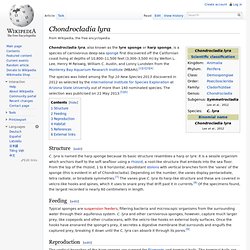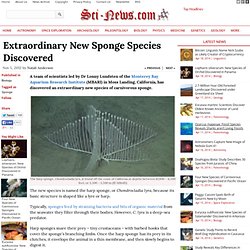

Extraordinary harp-shaped carnivorous sponge discovered living on the Pacific Ocean floor. Chondrocladia lyra lives at depths of 11,000ft of the coast of CaliforniaMarine biologists discovered it using remote-control deep-sea vehiclesIt traps traps and eats tiny crustaceans using hooks on its branching limbs By Damien Gayle Published: 12:14 GMT, 6 November 2012 | Updated: 12:37 GMT, 6 November 2012 Marine biologists scouring the seabed have discovered an new species of carnivorous sponge that bears a remarkable resemblance to a harp or lyre.

A team from the Monterey Bay Aquarium Research Institute (MBARI) in Moss Landing, California, found the weird deep-sea predator off their state's northern coast. They named the new species Chondrocladia lyra - or harp sponge - because the basic structure of its body is shaped like the musical instrument. New Carnivorous Sponge Looks Like A Harp. Chondrocladia lyra. Chondrocladia lyra, also known as the lyre sponge or harp sponge, is a species of carnivorous deep-sea sponge first discovered off the Californian coast living at depths of 10,800–11,500 feet (3,300–3,500 m) by Welton L.

Lee, Henry M Reiswig, William C. Austin, and Lonny Lundsten from the Monterey Bay Aquarium Research Institute (MBARI).[1][2][3][4] The species was listed among the Top 10 New Species 2013 discovered in 2012 as selected by the International Institute for Species Exploration at Arizona State University out of more than 140 nominated species. The selection was publicised on 22 May 2013.[5][6] Structure[edit] C. lyra is named the harp sponge because its basic structure resembles a harp or lyre. Feeding[edit] Typical sponges are suspension feeders, filtering bacteria and microscopic organisms from the surrounding water through their aquiferous system. Reproduction[edit] The vertical branches of the harp sponge are support for filaments and terminal balls. Habitat[edit] Article. Cladorhizidae - Information on Cladorhizidae. Cladorhizidae — Overview learn more about names for this taxon Add to a collection Media Cerianthid Trusted • Chondrocladia gigantea Trusted ... more taxon associations © SERPENT Media Archive Project Source: SERPENT project See all mediaSee all maps IUCN threat status: Not evaluated Brief summary No one has contributed a brief summary to this page yet.

Explore what EOL knows about Cladorhizidae. Add a brief summary to this page Present in 21 collections See all 21 collections in which this page appears. BioLib.cz Import732851 other itemsSloan-CoML NameLink Project1063 other itemsTaxon list327018 other items Belongs to 0 communities This taxon hasn't been featured in any communities yet. Learn more about Communities EOL has data for 9 traits See all 9 traits for this taxon. Found in 4 classifications See all 4 approved classifications in which this taxon appears.
Family recognized by World Register of Marine Species (WoRMS): Reviewed by 0 curators Learn how to curate. Scientists describe extroardinary new carnivorous sponge. Scientists discover extraordinary new carnivorous sponge Ten thousand feet below the ocean's surface, the seafloor is a dark, desolate, and dangerous place where even the most benign-looking creatures can be deadly predators.

Recently, a team of scientists discovered an unlikely new carnivorous species— the harp sponge (Chondrocladia lyra). C. lyra is called the harp sponge because its basic structure, called a vane, is shaped like a harp or lyre. Each vane consists of a horizontal branch supporting several parallel, vertical branches. But don't let the harp sponge's whimsical appearance and innocent sounding name fool you, it's actually a deep-sea predator.
Clinging with root-like "rhizoids" to the soft, muddy sediment, the harp sponge captures tiny animals that are swept into its branches by deep-sea currents. Using MBARI's remotely operated vehicles (ROVs) Tiburon and Doc Ricketts, researchers collected two sponges and made video observations of ten more. Article by Dana Lacono. Extraordinary New Sponge Species Discovered. A team of scientists led by Dr Lonny Lundsten of the Monterey Bay Aquarium Research Institute (MBARI) in Moss Landing, California, has discovered an extraordinary new species of carnivorous sponge.

The harp sponge, Chondrocladia lyra, is found off the coast of California at depths between 10,800 – 11,500 feet; or 3,300 – 3,500 m (© MBARI) The new species is named the harp sponge, or Chondrocladia lyra, because its basic structure is shaped like a lyre or harp. Typically, sponges feed by straining bacteria and bits of organic material from the seawater they filter through their bodies. Scientists Discover Extraordinary New Carnivorous Sponge. Video: Amazing New Predator. Every few months we see new land/aquatic discoveries in either the deep jungles or the vast seas.

Although these finds are often astounding to those who discover them, they are more a distraction from a day of drudgery to the masses. However, once in a while something comes along that actually gets us interested. Today we have one such example that might catch your eye. If you didn’t know it already, there are species of carnivorous sponges out there.
Notwithstanding is a newly discovered creation that puts all other flesh eating sponges to shame. Recently a brand new carnivorous sponge was discovered off the coast of California. Today we have video of this amazing ocean predator as well as some official sciencey commentary: OK, it’s not paranormal, nor is it a Bigfoot, but I think it fits right in with our search for crypto stuff. Here’s some even more official science commentary: Now the only question is, how big can one of these things get? NOTE: Video is the property of Viacom. Chondrocladia Lyra a Harp-Shaped Carnivorous Sponge. An extraordinary new carnivorous sponge, Chondrocladia lyra, in the new subgenus Symmetrocladia (Demospongiae, Cladorhizidae), from off of northern California, USA - Lee - 2012 - Invertebrate Biology.